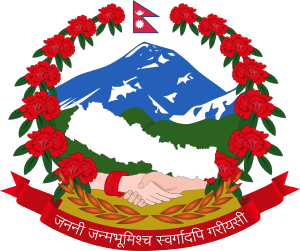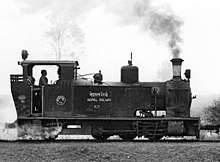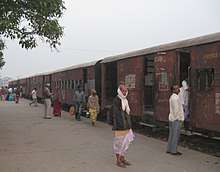Nepal Railways
The Nepal Railways Corporation Ltd. (NRC, reporting mark: NR / ने. रे) is a state-owned company which operates railways in Nepal.[1]
 | |
| Nepal Railways | |
Native name | नेपाल रेल्वे |
| Government sector | |
| Industry | Rail transport |
| Predecessor | Nepal Government Railway and Nepal Janakpur–Jaynagar Railway |
| Founded | 1927 |
| Founder | Chandra Shumsher Jang Bahadur Rana in association with British Indian Government |
| Headquarters | Bishalnagar, Kathmandu , |
Area served | Nepal |
Key people | Balram Mishra (Director General) |
| Owner | Government of Nepal |
| Parent | Government of Nepal |
| Website | www |
Jaynagar–Janakpur line | |||||||||||||||||||||||||||||||||||||||||||||||||||||||||||||||||||||||||||||||||||||||||||||||||||||||||||||||||||||||||||||||||||||||||||||||||||||||
|---|---|---|---|---|---|---|---|---|---|---|---|---|---|---|---|---|---|---|---|---|---|---|---|---|---|---|---|---|---|---|---|---|---|---|---|---|---|---|---|---|---|---|---|---|---|---|---|---|---|---|---|---|---|---|---|---|---|---|---|---|---|---|---|---|---|---|---|---|---|---|---|---|---|---|---|---|---|---|---|---|---|---|---|---|---|---|---|---|---|---|---|---|---|---|---|---|---|---|---|---|---|---|---|---|---|---|---|---|---|---|---|---|---|---|---|---|---|---|---|---|---|---|---|---|---|---|---|---|---|---|---|---|---|---|---|---|---|---|---|---|---|---|---|---|---|---|---|---|---|---|---|
| |||||||||||||||||||||||||||||||||||||||||||||||||||||||||||||||||||||||||||||||||||||||||||||||||||||||||||||||||||||||||||||||||||||||||||||||||||||||
It maintains and operates two railway lines in the country: the Raxaul–Sirsiya and the Jainagar–Janakpur. The former is a 6 km (3.7 mi) line from Raxaul, India to Sirsiya Inland Container Depot (or dry port) near Birganj, Nepal, and is primarily used for freight transport.[2] It allows container traffic to be imported to Nepal through the Sirsiya dry port container depot.[3] The latter is a 28 km (17 mi) line from Jaynagar, India to Janakpur, Nepal, and is used primarily for passenger transport.[4] Integral Coach Factory, Chennai has undertaken export of Diesel Electric Multiple Unit (DEMUs) as trainsets to Nepal.[5]
To date, Nepal's capital, Kathmandu, has no railway links.
History

The first railway in Nepal was the Nepal Government Railway (NGR), a 2 ft 6 in (762 mm) narrow gauge railway, built by the British in 1927, during the Rana period.[6] The railway connected Raxaul in British India with Amlekhganj in the Kingdom of Nepal.[7] This 39-kilometre-long (24 mi) line allowed people from different areas of the country to reach Amlekhganj, and helped move heavy vehicles to Bhimphedi. It was then possible to reach Kathmandu from Bhimphedi on foot. The railway possessed seven steam locomotives, 12 coaches and 82 wagons.[8] It operated steam-powered Garratt locomotives manufactured by Beyer, Peacock and Company of the United Kingdom.[9]

The second railway in the country was the Nepal Janakpur–Jaynagar Railway (NJJR), a 2 ft 6 in (762 mm) narrow gauge railway, built by the British in 1937, during the Rana period. This 28-mile-long (45 km) track was built to carry timber from the then heavily forested areas of Janakpur in the Kingdom of Nepal to Jaynagar in British India.[10] The railway was later extended to Bijalpura.
The Raxaul–Amlekhganj railway track was operational until 1965. It was closed down after opening of the Tribhuvan Highway.[11] The railway track from Raxaul was converted to 5 ft 6 in (1,676 mm) broad gauge by Indian Railways to connect Sirsiya (Birganj) Inland Container Depot (ICD). The railway became fully operational in 2005, though certain segments were used as early as 2002. It is used to move containers and other cargo to and from the Kolkata port and other places in India. It is the most important entry point for imports into China, and is essential for Nepal's commerce and trade. Birganj is located 700 km (430 mi) from the Kolkata port by railway.
After a washout of the railway embankment and two bridges, the track between Janakpur and Bijayalpura (22 km railway line) was closed in 2001. The remaining Janakpur–Jaynagar railway track was converted to 5 ft 6 in (1,676 mm) broad gauge in 2018. The extension to Bardibas remains under construction.[10]
Incidents
- In August 2012, a serious incident occurred when a locomotive ran away without bogies while a driver was putting in oil. The locomotive ran from Jaynagar to Janakpur at speeds far exceeding the restrictions on the line, resulting in the normally two-and-a-half hours journey of 29 km (18 mi) taking only 45 minutes. The staff at Janakpur diverted the locomotive engine onto a damaged track where its wheels became stuck in the ground and it came to a full stop without causing any injuries.[12][13]
Future
_under_construction_-_20180522_182458.jpg)
The below railway lines are either under construction or have been planned.
- East-West Railway or Mechi-Mahakali Railway: The railway feasibility study has been done with total of 945.244 km (587.347 mi) which will expand through 24 districts in the total cost of $3 billion.[14]
- Anbu Khaireni-Bharatpur - The feasibility study has done and railway will be constructed to link Kathmandu and Pokhara with the Mechi-Mahakali or the East-West Railway.[15]
- Jaynagar-Janakpur–Bijayalpura-Bardibas: The Jaynagar–Janakpur line is being extended further to Bardibas from Janakpur.[4]
- Kerung-Kathmandu: The railway will connect the capital city with China and the estimated cost is $2.75 billion. A 23-member technical and administrative team of National Railway Administration of China, led by its vice minister Zheng Jian contucted a four-day overall study.[15]
- Lumbini-Pokhara-Kathmandu: This will connect the popular tourist destination and adventureous city with the capital and the estimated cost is $3 billion.[15]
- Raxaul–Birgunj-Kathmandu: Nepal and India agreed to construct a railway line linking Raxaul with Kathmandu during Prime Minister KP Oli Sharma's visit to India.[16] A team of technical officers visited Kathmandu to study the proposed railway and they have stated that a feasibility study of the project would begin. They have already identified Chobhar as the terminus of the 113 km long railway line.[15][17][18][19]
- New Jalpaiguri (India) – Kakarbhitta (Nepal)[20]
- Bathnaha (India)- Jogbani (India) – Biratnagar (Nepal)[21][20]
- Nautanwa (India) – Bhairahawa (Nepal)[20]
- Rupaidiha,Nepalganj Road (India) – Nepalganj (Nepal)[20]
- China–Nepal Railway: A line linking India with Lhasa in Tibet through Kathmandu has been proposed by the K.P. Oli government. In November 2017, Chinese media reported the arrival of a delegation of Chinese railway experts to Nepal. The Chinese experts discussed the possibility of a railway connection between China and Nepal.[22] The two sides reached an agreement on construction details of the railway in August 2018.[23] The line is planned to use standard gauge.[24]
See also
| Wikimedia Commons has media related to Nepal Railways. |
- Railway stations in Nepal
- Transport in Nepal
- Railway stations in India
- Janakpur- The City Of First Railway in Nepal
References
- "नेपाल सरकार भौतिक पुर्वाधार तथा यातायात मन्त्रालय रेल विभाग विशालनगर, काठमाण्डौ". www.dorw.gov.np. Retrieved 7 March 2020.
- "Nepal Railway Assessment". Retrieved 4 August 2018.
- "Introduction". customs.gov.np. Department of Customs dryport office, Government of Nepal. Retrieved 3 December 2017.
- Shashi, Shyamsundar (10 August 2018). "Indian goods train from Jayanagar arrives in Janakpur". kathmandupost.com. KMG. Retrieved 7 March 2020.
- Prasain, Krishana (January 16, 2020). "Janakpur-Jayanagar rail service to resume operations by March". In May 2018, the Railways Department signed an agreement with the Indian coach manufacturer Integral Coach Factory of Chennai. kathmandupost.com. Kantipur Media Group. Retrieved 7 March 2020.
- Aitchison, Sir Charles Umpherston (1929). A Collection of Treaties, Engagements and Sanads Relating to India and Neighbouring Countries, Volume 14. Government of India Central Publication Branch. p. 47. Retrieved 29 July 2013.
- "Railway in Nepal and it's scope". 20 February 2018. Archived from the original on 4 August 2018. Retrieved 4 August 2018.
- "Railroads". A Country Study: Nepal. The Library of Congress. 22 March 2011. Retrieved 26 July 2013.
- "Garratt Locomotives produced by Beyer Peacock". Retrieved 29 July 2013.
- "The Janakpur Railway - The longest railway line of Nepal". Retrieved 4 August 2018.
- A National Transport System for Nepal (PDF). Washington, D.C.: World Bank. June 1965. p. 22. Retrieved 25 May 2014.
- "Train engine from India completes journey to Nepal sans driver". www.deccanherald.com. 8 August 2012. Retrieved 7 March 2020.
- "Train engine from India completes journey to Nepal sans drive". m.indiarailinfo.com. 8 August 2012. Retrieved 7 March 2020.
- "EAST-WEST ELECTRIFIED RAILWAY PROJECT" (PDF). Project Bank-EWER.pdf. Retrieved 7 March 2020.
- Tiwari, Nandalal. "The Talk Of Kerung-Kathmandu Railway". The Rising Nepal. Retrieved 7 March 2020.
- "India And Nepal To Speed Up Raxaul-Kathmandu Rail Project". 11 July 2018. Retrieved 4 August 2018.
- "DoR says land acquisition a major hurdle". www.kathmandupost.ekantipur.com. Kantipur Publications. 24 July 2018. Retrieved 16 August 2018.
- "DoR starts construction of 10 railway tracks". thehimalayantimes.com. 11 June 2018. Retrieved 7 March 2020.
- Neupane, Suresh Raj (9 June 2019). "Raxaul-Kathmandu rail survey report is ready, Indian officials say". kathmandupost.com. KMG. Retrieved 7 March 2020.
- "India-Nepal Statement on Expanding Rail Linkages". MOFA- Point No. 4. April 7, 2018. Retrieved 7 March 2020.
- Sah, Deo Narayan (6 October 2018). "Bathana-Biratnagar rail by October end". kathmandupost.com. KMG. Retrieved 7 March 2020.
- 中方铁路代表团赴尼泊尔开展铁路调研 (A team of Chinese railway representatives visit Nepal to initiate a railway study), 2017-11-14
- Giri, A; Giri, S (24 August 2018). "Nepal, China agree on rail study". The Kathmandu Post. Retrieved 22 September 2018.
- "Nepal to use Chinese gauge for its railway, not the one India uses". Reuters. 2019-03-05. Retrieved 2019-09-01.